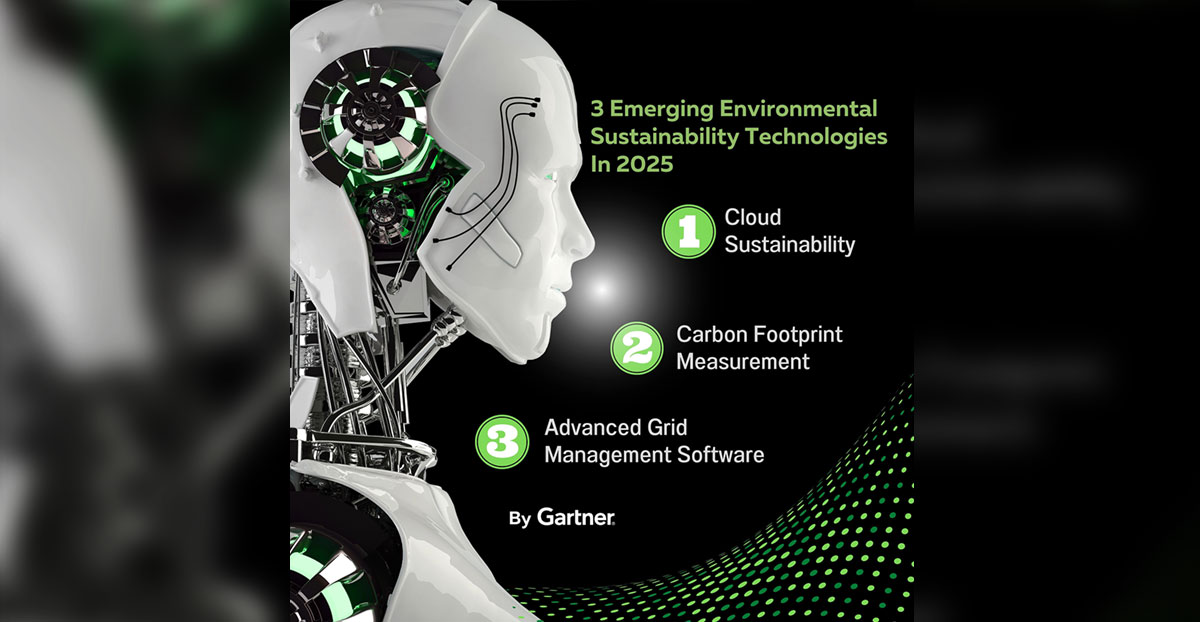นำโดย Cloud Sustainability, Carbon Footprint Measurement และ Advanced Grid Management Software ที่จะสร้างแรงกระเพื่อมต่อธุรกิจเป็นวงกว้างภายใน 1-3 ปี
การ์ทเนอร์ เผย 3 เทคโนโลยีเกิดใหม่ด้านความยั่งยืนด้านสิ่งแวดล้อม ได้แก่ Cloud Sustainability, Carbon Footprint Measurement และ Advanced Grid Management Software จะถูกนำมาใช้ขับเคลื่อนองค์กรอย่างแพร่หลายภายในหนึ่งถึงสามปีจากนี้
แอนเน็ต ซิมแมร์มันน์ รองประธานฝ่ายวิจัยของการ์ทเนอร์ กล่าวว่า “ความยั่งยืนด้านสิ่งแวดล้อมไม่ควรต้องเป็นความรับผิดชอบของอุตสาหกรรมเพียงไม่กี่แห่ง ถ้าเรื่องสภาวะภูมิอากาศเป็นเรื่องที่ต้องได้รับการปกป้องคุ้มครองแล้ว เรื่องของธุรกิจที่ยั่งยืนต้องมีความสำคัญระดับโลก การเปลี่ยนผ่านไปสู่เศรษฐกิจที่เป็นมิตรต่อสิ่งแวดล้อม (Net-Zero Economy) จะสร้างปรากฎการณ์อย่างยิ่งใหญ่เช่นเดียวกับการปฏิวัติอุตสาหกรรมหรือการปฏิวัติทางดิจิทัล ซึ่งต้องใช้เทคโนโลยี รูปแบบธุรกิจ กลยุทธ์และกระบวนการใหม่”
เส้นทางสู่อนาคตของ Net-Zero จะสร้างโอกาสใหม่ ๆ แก่ผู้ให้บริการทางด้านเทคโนโลยีที่มุ่งพัฒนาเทคโนโลยีรองรับการสร้างธุรกิจยั่งยืน การ์ทเนอร์ได้ระบุ 3 เทคโนโลยีเกิดใหม่ 3 ประการ ที่จะสร้างผลกระทบโดยตรงต่อความยั่งยืนด้านสิ่งแวดล้อม ได้แก่:
ความยั่งยืนของคลาวด์ (Cloud Sustainability)
Cloud Sustainability คือ แนวทางการใช้บริการคลาวด์เพื่อให้เกิดประโยชน์ด้านความยั่งยืนภายในระบบเศรษฐกิจ สิ่งแวดล้อมและสังคม ซึ่งประกอบด้วยการดำเนินการที่ยั่งยืนและการส่งมอบบริการคลาวด์โดยผู้ให้บริการ ตลอดจนการบริโภคและการใช้บริการคลาวด์อย่างยั่งยืน
“บริการคลาวด์สาธารณะนำเสนอศักยภาพด้านความยั่งยืนที่ยอดเยี่ยมด้วยความสามารถในการรวมศูนย์การดำเนินงานด้านไอทีโดยเป็นการดำเนินการที่ปรับได้โดยอาศัยโมเดลบริการที่ใช้ร่วมกัน ส่งผลให้ประสิทธิภาพของการประมวลผลสูงขึ้น โดยผู้ให้บริการคลาวด์สาธารณะยังมีความสามารถเฉพาะในการลงทุนเพื่อพัฒนาขีดความสามารถด้านความยั่งยืน อาทิ ย้ายที่ตั้งคลาวด์ดาต้าเซ็นเตอร์ให้อยู่ใกล้แหล่งพลังงานหมุนเวียน” ซิมแมร์มันน์กล่าวเพิ่มเติมว่า
ในอีกสามปีข้างหน้า ผู้ให้บริการระบบคลาวด์จะอยู่ภายใต้แรงกดดันที่เพิ่มขึ้นกับการจัดหากลยุทธ์ด้านสภาวะอากาศที่โปร่งใสพร้อมกับแผนงานที่ชัดเจน โดยการ์ทเนอร์คาดการณ์ว่าภายในปี 2568 การปล่อยก๊าซคาร์บอนไดออกไซด์จากบริการคลาวด์แบบไฮเปอร์สเกลจะเป็นเกณฑ์หนึ่งในสามอันดับแรกในการตัดสินใจซื้อระบบคลาวด์
การประเมินด้านรอยเท้าคาร์บอน (Carbon Footprint Measurement)
รอยเท้าคาร์บอน (Carbon Footprint) คือ ปริมาณการปล่อยมลพิษที่เกิดจากกิจกรรมของมนุษย์ สำหรับรอยเท้าคาร์บอนของผลิตภัณฑ์หรือบริการทางเทคโนโลยีจะครอบคลุมขอบเขตการปล่อยมลพิษสามประการ ได้แก่:
- ขอบเขตที่ 1: การปล่อยโดยตรงจากเจ้าของหรือที่มาที่ได้อยู่ในการควบคุม
- ขอบเขตที่ 2: การปล่อยทางอ้อมที่เกิดจากกระบวนการผลิตพลังงานที่ซื้อมา
- ขอบเขตที่ 3: การปล่อยทางอ้อมอื่น ๆ ทั้งหมด (ที่ไม่รวมอยู่ในขอบเขตที่ 2) เกิดขึ้นในห่วงโซ่คุณค่า (Value Chain) ของหน่วยงานที่จัดทำรายงาน รวมถึงการปล่อยจากต้นน้ำและปลายน้ำ
ซึ่งการปล่อยมลพิษในขอบเขตที่ 3 เป็นการวัดผลที่ท้าทายที่สุด แต่ในบางองค์กรการปล่อยก๊าซฯ นั้นคิดเป็นสัดส่วนมากกว่า 95% ของปริมาณการปลดปล่อยทั้งหมด การ์ทเนอร์คาดการณ์ว่าจะเห็นการนำเทคโนโลยีการวัดค่าคาร์บอนฟุตพริ้นท์ไปใช้อย่างมีนัยสำคัญ เนื่องจากองค์กรต่าง ๆ ได้ให้ความสำคัญในเรื่องการปล่อยมลพิษทั้ง 3 ประเภทและจัดทำรายงานความโปร่งใสเพิ่มมากขึ้น ซึ่งการเติบโตของเครื่องมือวัดผลเหล่านี้ได้รับแรงสนับสนุนมาจากการเพิ่มจำนวนของเซ็นเซอร์ตรวจจับด้านสิ่งแวดล้อมที่เปิดใช้งานเทคโนโลยี IoT ทั้งปริมาณ คุณภาพ และเวลาในการรวบรวมข้อมูลที่ใช้น้อยลง
“ท้ายที่สุด ทุกองค์กรจะต้องลงทุนในเครื่องมือวัดผลคาร์บอน รวมถึงซอฟต์แวร์โซลูชันที่ทำให้การวัดคาร์บอนที่โปร่งใสและคำแนะนำในเชิงปฏิบัติที่กำลังถูกนำไปใช้เพิ่มขึ้น โดยการ์ทเนอร์คาดว่าการเติบโตจะเกิดขึ้นอย่างต่อเนื่องเช่นเดียวกับความสามารถในการรวมระบบที่จะมีความคืบหน้ามากขึ้น” ซิมแมร์มันน์กล่าวเพิ่มเติม
ซอฟต์แวร์การจัดการกริดขั้นสูง (Advanced Grid Management Software)
Advanced Grid Management Software ประกอบด้วย ระบบวัดค่าและควบคุมเครื่องจักร (Supervisory Control and Data Acquisition (SCADA) ระบบการจัดการพลังงานจากสาธารณูปโภค และความสามารถใหม่ในการปฏิบัติงานแบบเรียลไทม์ ซึ่งได้รับมาจากโมเดลการเรียนรู้ทางกายภาพและเครื่องจักร ซึ่งซอฟต์แวร์นี้ถูกนำมาใช้โดยผู้ปฏิบัติงานระบบไฟฟ้าสำหรับตรวจสอบและควบคุมแหล่งพลังงานทั่วทั้งโครงข่ายไฟฟ้า เพื่อรักษาเสถียรภาพของระบบและชะลอการลงทุนขององค์กร
การ์ทเนอร์ คาดว่าปัจจุบันมีองค์กรประมาณ 5-20% ลงทุนซอฟต์แวร์การจัดการกริดขั้นสูง และจะมีแนวโน้มเพิ่มขึ้นอย่างมากในช่วงหนึ่งถึงสามปีข้างหน้า โดยภายในปี 2569 การ์ทเนอร์คาดกว่า 60% ของโครงการลงทุนจากบริษัทพลังงานที่ใหญ่ที่สุดจะมุ่งเน้นด้านพลังงานหมุนเวียนความเสี่ยงต่ำ
“ความท้าทายหลักของผู้ให้บริการโครงข่ายกริดคือการจัดการความแปรปรวนของกระแสไฟฟ้าและความผันแปรของโปรไฟล์พลังงาน ซึ่งซอฟต์แวร์การจัดการกริดขั้นสูงจะสนับสนุนการเปลี่ยนแปลงด้านพลังงาน เปลี่ยนบริษัทสาธารณูปโภคไฟฟ้าแบบเดิมให้กลายเป็นผู้จัดการโครงข่ายที่มีประสิทธิภาพที่สามารถสร้างสมดุลระหว่างความไม่เสถียรที่เกิดจากการเพิ่มปริมาณพลังงานหมุนเวียนที่ไม่ต่อเนื่อง” ซิมแมร์มันน์กล่าวเพิ่มเติม
